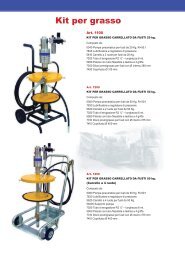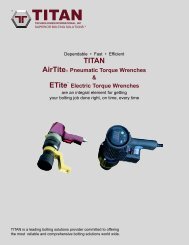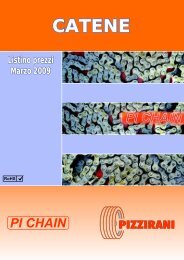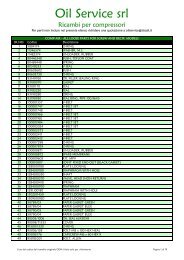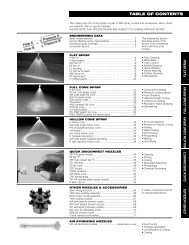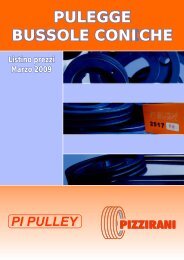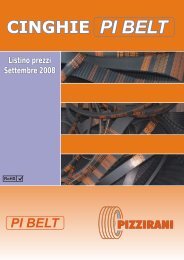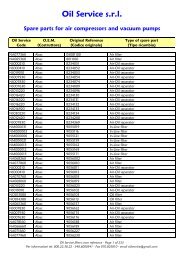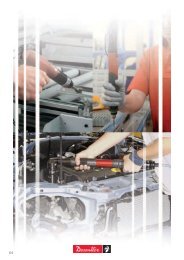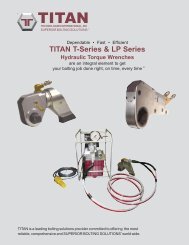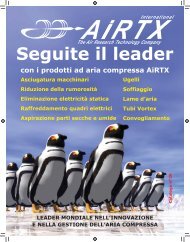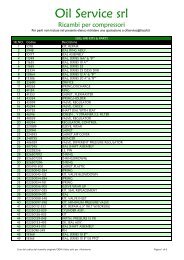Informazioni sui consumi di aria compressa - Oil Service
Informazioni sui consumi di aria compressa - Oil Service
Informazioni sui consumi di aria compressa - Oil Service
You also want an ePaper? Increase the reach of your titles
YUMPU automatically turns print PDFs into web optimized ePapers that Google loves.
Prodotti AiRTX per l’amplificazione dell’<strong>aria</strong><br />
Prodotti AiRTX per l’amplificazione della portata <strong>di</strong> <strong>aria</strong> <strong>compressa</strong><br />
per darvi più performance con minore rumore<br />
Standard <strong>di</strong> sicurezza OSHA<br />
- Proteggere gli occhi quando si utilizza <strong>aria</strong> <strong>compressa</strong> per soffiare superfici e rimuovere parti.<br />
- In con<strong>di</strong>zioni <strong>di</strong> sicurezza gli ugelli ad <strong>aria</strong> <strong>compressa</strong> non dovrebbero superare una forza <strong>di</strong> soffiaggio <strong>di</strong> 2 Bar.<br />
- In con<strong>di</strong>zioni <strong>di</strong> sicurezza gli ugelli ad <strong>aria</strong> <strong>compressa</strong> dovrebbero essere costruiti in modo che non vengano<br />
causati danni alla pelle degli operatori; a questo scopo è necessario prevedere nell’impianto tubi <strong>di</strong> sfogo e sfiati<br />
in modo che la forza dell’<strong>aria</strong> <strong>compressa</strong> all’uscita da un ugello o da un tubo abbia una valvola <strong>di</strong> sicurezza che<br />
prevenga il danneggiamento della pelle dell’operatore.<br />
Livello <strong>di</strong> rumore degli amplificatori <strong>di</strong><br />
portata e degli ugelli AiRTX<br />
<strong>Informazioni</strong> generali sul rumore in posti <strong>di</strong> lavoro<br />
Modello Livello <strong>di</strong> rumore dBA Bar Litri/min<br />
30038<br />
48009<br />
15008<br />
15015<br />
85006<br />
85012<br />
38050<br />
76<br />
72<br />
72<br />
76<br />
72<br />
72<br />
74<br />
5,5<br />
5,5<br />
5,5<br />
5,5<br />
5,5<br />
5,5<br />
5,5<br />
424<br />
424<br />
424<br />
560<br />
680<br />
1.360<br />
424<br />
Livello <strong>di</strong> rumore<br />
dBA<br />
110<br />
105<br />
102<br />
92<br />
90<br />
85<br />
60<br />
Applicazione<br />
Tubo aperto <strong>di</strong>ametro 1/2”<br />
Tubo aperto <strong>di</strong>ametro 3/8”<br />
Tubo in rame <strong>di</strong>ametro 1/4”<br />
Tolleranza raccomandata da NIOSH<br />
(Senza protezione dell’u<strong>di</strong>to)<br />
30 minuti<br />
1 ora<br />
90 min<br />
6 ore<br />
8 ore<br />
Obiettivo <strong>di</strong>rumore per la maggior parte delle produzioni industriali<br />
Normale conversazione - Un incremento o un decremento del 10% nel<br />
livello <strong>di</strong> rumore produce una sostanziale <strong>di</strong>fferenza nelle possibilità<br />
che l’u<strong>di</strong>to possa essere danneggiato a causa del rumore<br />
Pressione dell’<strong>aria</strong> <strong>compressa</strong> - Alcune delle cause più comuni <strong>di</strong> bassa pressione<br />
- La richiesta da parte dell’impianto è troppo alta rispetto alla produzione d’<strong>aria</strong><br />
- Per<strong>di</strong>te <strong>di</strong> <strong>aria</strong> <strong>compressa</strong>; le per<strong>di</strong>te standard in uno stabilimento sono circa il 20% dell’<strong>aria</strong> prodotta<br />
- Tubi e connessioni sotto<strong>di</strong>mensionati<br />
- Per<strong>di</strong>te dovute all’attrito all’interno delle tubazioni, curve nei tubi, tubi vecchi e con corrosione interna<br />
Caratteristiche della pressione dell’<strong>aria</strong><br />
con applicazione con tubo in gomma<br />
Caduta <strong>di</strong> pressione per attrito<br />
Tubo in gomma lungo 16,5 metri con pressione ad inizio tubo 7 bar<br />
Portata<br />
litri/min<br />
280<br />
560<br />
850<br />
1.140<br />
1.415<br />
1.700<br />
Consumo<br />
<strong>aria</strong> <strong>compressa</strong><br />
litri/min<br />
0-566<br />
566-1.132<br />
1.132-2.120<br />
2.120-3.400<br />
3.400-4.000<br />
Diametro interno del tubo in gomma<br />
La tabella riporta la caduta <strong>di</strong> pressione (Bar) dovuta ad attrito<br />
alla fine tubo da 16,5 metri, in relazione al <strong>di</strong>ametro del tubo usato<br />
1/4” 3/8” 1/2” 3/4” 1”<br />
0,11<br />
0,62<br />
1,85<br />
3,01<br />
4,20<br />
-<br />
0,05<br />
0,28<br />
0,60<br />
1,21<br />
2,04<br />
3,43<br />
- - -<br />
0,05<br />
0,16<br />
0,33<br />
0,58<br />
0,92<br />
Diametri raccomandati<br />
per i tubi d’<strong>aria</strong> <strong>compressa</strong><br />
0,01<br />
0,03<br />
0,04<br />
0,07<br />
0,10<br />
Diametro minimo del tubo (Pollici)<br />
in relazione alla lunghezza del tubo<br />
0-4 metri 4-17 metri 17-66 metri<br />
5/16<br />
3/8<br />
1/2<br />
3/4<br />
1<br />
3/8<br />
1/2<br />
1/2<br />
3/4<br />
1<br />
1/2<br />
1/2<br />
3/4<br />
1<br />
1 1/4<br />
-<br />
0,01<br />
0,01<br />
0,01<br />
0,03<br />
Caratteristiche della pressione dell’<strong>aria</strong><br />
con applicazione con tubo rigido<br />
Caduta <strong>di</strong> pressione per attrito<br />
Tubo rigido lungo 16,5 metri con pressione ad inizio tubo 7 bar<br />
Portata<br />
litri/min<br />
280<br />
560<br />
850<br />
1.140<br />
1.415<br />
1.700<br />
Diametro interno del tubo rigido<br />
La tabella riporta la caduta <strong>di</strong> pressione (Bar) dovuta ad attrito<br />
alla fine tubo da 16,5 metri, in relazione al <strong>di</strong>ametro del tubo usato<br />
1/4” 3/8” 1/2” 3/4” 1”<br />
0,12<br />
0,65<br />
1,97<br />
3,19<br />
4,44<br />
-<br />
0,03<br />
0,32<br />
0,63<br />
1,29<br />
2,14<br />
3,67<br />
0,02 - -<br />
0,09<br />
0,21<br />
0,35<br />
0,66<br />
1,03<br />
0,01<br />
0,03<br />
0,06<br />
0,09<br />
0,13<br />
-<br />
0,01<br />
0,02<br />
0,02<br />
0,03<br />
AMPLIFICAZIONE ARIA<br />
Formula <strong>di</strong> conversione: 1 bar = 10197 Kgf/m 2 = 14,505 Psi<br />
Fax 070.825810 - posta elettronica oilservice@gmail.com<br />
17



